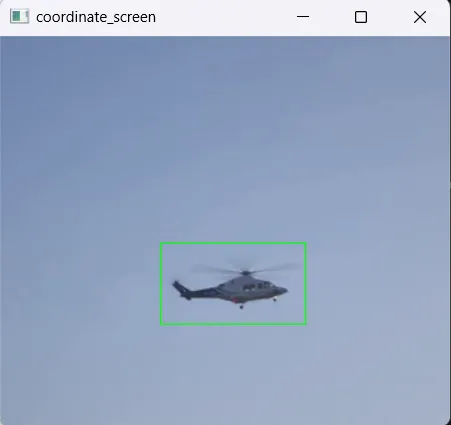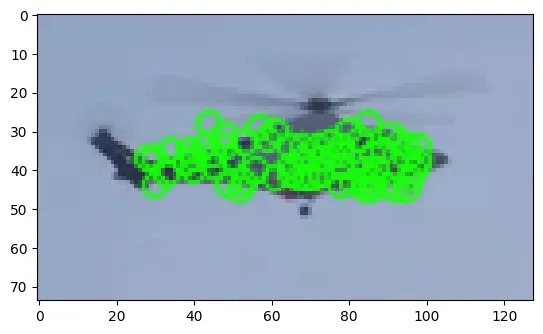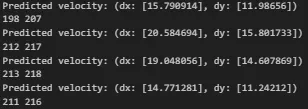目標跟蹤器 | Kalman + FAST 預測物體運動 | 附代碼
對于目標跟蹤,有諸如FAST、SURF、SIFT和ORB等特征提取算法。在從目標物體提取特征后,可以嘗試對每一幀的這些特征進行跟蹤,通過這種方式,可以創建一個簡單的目標跟蹤器。但是,如何預測物體的運動呢?可能想知道1秒后目標物體將位于何處。僅使用特征提取算法是無法做到的,但不用擔心,卡爾曼濾波器非常適合運動預測任務。在本文中,我將展示如何使用卡爾曼濾波器和FAST算法來跟蹤物體并預測物體的運動。

紅色圓圈 → 運動預測
卡爾曼濾波器和FAST算法
卡爾曼濾波器使用過去的數據來預測物體的運動。使用卡爾曼濾波器時,必須跟蹤一個物體,因為卡爾曼濾波器需要位置數據,基于這些位置數據,它預測物體的位置。
使用FAST算法,我將跟蹤物體,提取中心坐標,并使用這些數據與卡爾曼濾波器一起預測物體的位置。
NOTE: 關于FAST算法的文章,后續我們有機會將進行詳細解讀。
代碼/跟蹤和預測物體的運動 → FAST + 卡爾曼濾波器
主要有5個步驟,我將逐一解釋它們。
# Import Necessary Libraries
import cv2
import numpy as np
import matplotlib.pyplot as plt
import time1.使用FAST算法提取跟蹤特征:用鼠標左鍵在目標物體周圍畫一個矩形框,將從這個矩形框中提取特征。
# Path to video
video_path = r"videos/helicopter3.mp4"
video = cv2.VideoCapture(video_path)
# read only the first frame for drawing a rectangle for the desired object
ret,frame = video.read()
# I am giving big random numbers for x_min and y_min because if you initialize them as zeros whatever coordinate you go minimum will be zero
x_min,y_min,x_max,y_max=36000,36000,0,0
def coordinat_chooser(event,x,y,flags,param):
global go , x_min , y_min, x_max , y_max
# when you click the right button, it will provide coordinates for variables
if event==cv2.EVENT_LBUTTONDOWN:
# if current coordinate of x lower than the x_min it will be new x_min , same rules apply for y_min
x_min=min(x,x_min)
y_min=min(y,y_min)
# if current coordinate of x higher than the x_max it will be new x_max , same rules apply for y_max
x_max=max(x,x_max)
y_max=max(y,y_max)
# draw rectangle
cv2.rectangle(frame,(x_min,y_min),(x_max,y_max),(0,255,0),1)
"""
if you didn't like your rectangle (maybe if you made some misscliks), reset the coordinates with the middle button of your mouse
if you press the middle button of your mouse coordinates will reset and you can give a new 2-point pair for your rectangle
"""
if event==cv2.EVENT_MBUTTONDOWN:
print("reset coordinate data")
x_min,y_min,x_max,y_max=36000,36000,0,0
cv2.namedWindow('coordinate_screen')
# Set mouse handler for the specified window, in this case, "coordinate_screen" window
cv2.setMouseCallback('coordinate_screen',coordinat_chooser)
while True:
cv2.imshow("coordinate_screen",frame) # show only first frame
k = cv2.waitKey(5) & 0xFF # after drawing rectangle press ESC
if k == 27:
cv2.destroyAllWindows()
break
繪制矩形框以定位目標
2. 顯示提取的特征:使用FAST算法從矩形框中提取特征。
# take region of interest ( take inside of rectangle )
roi_image=frame[y_min+2:y_max-2,x_min+2:x_max-2]
roi_rgb=cv2.cvtColor(roi_image,cv2.COLOR_BGR2RGB)
# convert roi to grayscale, SIFT Algorithm works with grayscale images
roi_gray=cv2.cvtColor(roi_image,cv2.COLOR_BGR2GRAY)
# Initialize the FAST detector and BRIEF descriptor extractor
fast = cv2.FastFeatureDetector_create(threshold=1)
brief = cv2.xfeatures2d.BriefDescriptorExtractor_create()
# detect keypoints
keypoints_1 = fast.detect(roi_gray, None)
# descriptors
keypoints_1, descriptors_1 = brief.compute(roi_gray, keypoints_1)
# draw keypoints for visualizing
keypoints_image = cv2.drawKeypoints(roi_rgb, keypoints_1, outImage=None, color=(23, 255, 10))
# display keypoints
plt.imshow(keypoints_image,cmap="gray")
提取的特征
3.創建一個提取目標物體中心位置的函數
# matcher object
bf = cv2.BFMatcher()
def detect_target_fast(frame):
# convert frame to gray scale
frame_gray = cv2.cvtColor(frame, cv2.COLOR_BGR2GRAY)
# Detect keypoints using FAST
keypoints_2 = fast.detect(frame_gray, None)
# Compute descriptors using BRIEF
keypoints_2, descriptors_2 = brief.compute(frame_gray, keypoints_2)
"""
Compare the keypoints/descriptors extracted from the
first frame (from target object) with those extracted from the current frame.
"""
if descriptors_2 is not None:
matches = bf.match(descriptors_1, descriptors_2)
if matches:
# Initialize sums for x and y coordinates
sum_x = 0
sum_y = 0
match_count = 0
for match in matches:
# .trainIdx gives keypoint index from current frame
train_idx = match.trainIdx
# current frame keypoints coordinates
pt2 = keypoints_2[train_idx].pt
# Sum the x and y coordinates
sum_x += pt2[0]
sum_y += pt2[1]
match_count += 1
# Calculate average of the x and y coordinates
avg_x = sum_x / match_count
avg_y = sum_y / match_count
return int(avg_x),int(avg_y)4.初始化卡爾曼濾波器
# Initialize Kalman filter parameters
kalman = cv2.KalmanFilter(4, 2)
kalman.measurementMatrix = np.array([[1, 0, 0, 0], [0, 1, 0, 0]], np.float32)
kalman.transitionMatrix = np.array([[1, 0, 1, 0], [0, 1, 0, 1], [0, 0, 1, 0], [0, 0, 0, 1]], np.float32)
kalman.processNoiseCov = np.eye(4, dtype=np.float32) * 0.03 # Process noise
kalman.measurementNoiseCov = np.eye(2, dtype=np.float32) * 0.5 # Measurement noise5.讀取視頻并使用卡爾曼濾波器和FAST算法
# Startcapturing the video from file
cap = cv2.VideoCapture(video_path)
while True:
ret, frame = cap.read()
if not ret:
break
# Predict the new position of the ball
predicted = kalman.predict()
predicted_x, predicted_y = int(predicted[0]), int(predicted[1])
predicted_dx, predicted_dy = predicted[2], predicted[3] # Predicted velocity
print(predicted_x, predicted_y )
print(f"Predicted velocity: (dx: {predicted_dx}, dy: {predicted_dy})")
# Detect the ball in the current frame
ball_position = detect_target_fast(frame)
if ball_position:
measured_x, measured_y = ball_position
# Correct the Kalman Filter with the actual measurement
kalman.correct(np.array([[np.float32(measured_x)], [np.float32(measured_y)]]))
# Draw the detected ball
cv2.circle(frame, (measured_x, measured_y), 6, (0, 255, 0), 2) # green --> correct position
# Draw the predicted position (Kalman Filter result)
cv2.circle(frame, (predicted_x, predicted_y), 8, (0, 0, 255), 2) # red --> predicted position
# Show the frame
cv2.imshow("Kalman Ball Tracking", frame)
# Break on 'q' key press
if cv2.waitKey(30) & 0xFF == ord('q'): # 30 ms delay for smooth playback
break
cap.release()
cv2.destroyAllWindows()
終端輸出

跟蹤和預測飛機






































